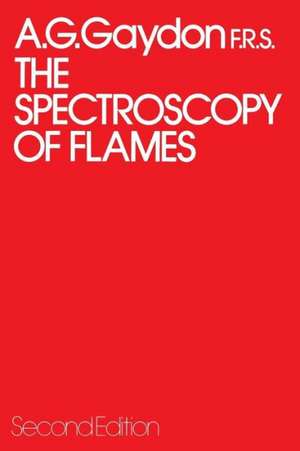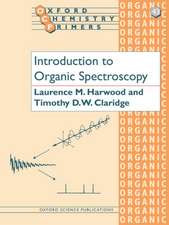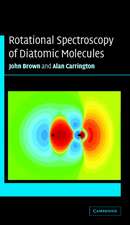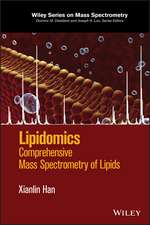The Spectroscopy of Flames
Autor A. Gaydonen Limba Engleză Paperback – 13 noi 2013
Preț: 704.04 lei
Preț vechi: 828.27 lei
-15% Nou
Puncte Express: 1056
Preț estimativ în valută:
134.74€ • 139.19$ • 112.13£
134.74€ • 139.19$ • 112.13£
Carte tipărită la comandă
Livrare economică 25 martie-08 aprilie
Preluare comenzi: 021 569.72.76
Specificații
ISBN-13: 9789400957220
ISBN-10: 940095722X
Pagini: 444
Ilustrații: XII, 412 p. 20 illus.
Dimensiuni: 155 x 235 x 23 mm
Greutate: 0.62 kg
Ediția:Softcover reprint of the original 1st ed. 1974
Editura: SPRINGER NETHERLANDS
Colecția Springer
Locul publicării:Dordrecht, Netherlands
ISBN-10: 940095722X
Pagini: 444
Ilustrații: XII, 412 p. 20 illus.
Dimensiuni: 155 x 235 x 23 mm
Greutate: 0.62 kg
Ediția:Softcover reprint of the original 1st ed. 1974
Editura: SPRINGER NETHERLANDS
Colecția Springer
Locul publicării:Dordrecht, Netherlands
Public țintă
ResearchCuprins
I. Flame Spectra.- The purpose of studying flame spectra.- Types of spectra.- The structure of flames.- The spectrum of the Bunsen flame.- Equilibria, radiation and collision processes.- II. Experimental Methods.- The recording of spectra.- Spectrographic equipment.- Optical systems.- The study of absorption spectra.- Wavelength determination.- Intensity measurements.- Effects of flame shape.- III. Special Techniques.- Flat flames.- Low-pressure flames.- Temperature effects on flames.- Atomic flames.- Flash photolysis.- Shock tube studies.- Fluorescence and laser-Raman scattering.- Use of isotope shifts.- IV. Introduction to the Theory of Spectra.- Line or atomic spectra.- Bohr theory.- The spectra of diatomic molecules: vibrational structure.- Rotational structure of the spectra of diatomic molecules.- Electronic states of diatomic molecules.- Vibrational intensity distribution: the Franck.- Condon principle.- Predissociation.- Infra-red spectra.- Raman spectra.- Electronic spectra of polyatomic molecules.- Continuous spectra.- Ionization continua.- Dissociation continua.- Association continua.- The width and shape of spectrum lines.- V. Hydrogen Flames.- The OH bands.- Hydrogen/air flames.- Hydrogen/ oxygen flames.- Pressure effects.- Absorption spectra.- Excitation of metal spectra in H2/O2/N2 flames.- Candoluminescence.- Applications to combustion mechanism.- The hydrogen/nitrous oxide flame.- Flames with NO and NO2.- VI. The Carbon Monoxide Flame.- The spectrum.- The carbon monoxide flame bands.- The excitation of the flame bands.- The continuous spectrum: pressure and temperature effects.- Combustion processes for carbon monoxide.- Flames of carbon and carbon suboxide.- VII. The Spectra of Organic Flames.- The CH bands.- Bands of C2.- Vaidya’s hydrocarbon flamebands (HCO).- The 4050 Å “comet head” group (C3).- Emeléus’s cool flame bands (CH2O).- Band systems of CO.- Other band systems in flames.- The carbon line, ?2478.- Premixed flames.- Diffusion flames.- Cool flames and preignition glows.- Absorption spectra.- VIII. Measurements of Effective Temperature and Studies with Special Sources.- Electronic excitation temperatures.- Translational temperatures from Doppler broadening.- Measurement of rotational temperatures: OH.- Rotational temperatures for CH, C2, NH etc.- Effective vibrational temperatures.- Predissociation.- Flash photolysis.- Atomic flames.- Spectra excited by shock waves.- Occurrence of C2 and CH in some special flames.- Isotope tracer experiments.- IX. The Infra-Red Region.- The amount of radiation from flames.- Infra-red spectra of organic flames.- Relative band intensities and temperature measurements.- Radiation from explosion flames.- Cool flames.- Flames with nitrous oxide.- Flames with halogens.- X. Flame Structure and Reaction Processes.- Reactions in cool flames.- The formaldehyde excitation process.- Reactions in diffusion flames.- Reactions in premixed flames.- Carbon formation in premixed flames.- Concentrations of free radicals.- Reactions forming excited species.- Ionization and electron temperatures.- The high electronic excitation in the flame front.- Effects on flame structure of lags in equipartition of energy.- XI. Explosions, Engines and Industrial Flames.- Explosions in closed vessels.- Detonations.- The internal combustion engine: flame fronts and afterburning.- Knock.- Compression-ignition (diesel) engines.- Engines with continuous combustion.- Exhaust flames.- Furnace flames.- Solid propellants.- XII. Flames Containing Nitrogen, Halogens, Sulphur and Inorganic Substances.-Flames of ammonia, hydrazine etc.- Flames of organic nitrogen compounds.- Flames supported by oxides of nitrogen.- Formation of oxides of nitrogen.- Ozone.- Halogens in oxidizing flames.- Flames supported by halogens.- Flames of sulphur, hydrogen sulphide and carbon disulphide.- Flames with added SO2, SO3 or H2S.- Phosphorus in flames.- Flames containing boron.- Metals in flames.- XIII. Flame Spectrophotometry.- The choice of flame type.- The burner and spray system.- Recording methods.- The relation between line intensity and concentration.- Interference by one element with the estimation of another.- Atomic absorption.- Atomic fluorescence.- Effects of flame disequilibria.- I Band spectra emitted by flames.- II Absorption spectra.- III Some atomic and molecular energy levels and constants.- References.- Author Index.- Subject Index (Including symbols used and values of physical constants).











